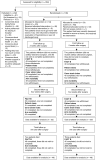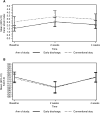Patient, carer and health service outcomes of nurse-led early discharge after breast cancer surgery: a randomised controlled trial
- PMID: 15238983
- PMCID: PMC2364768
- DOI: 10.1038/sj.bjc.6601998
Patient, carer and health service outcomes of nurse-led early discharge after breast cancer surgery: a randomised controlled trial
Abstract
Patients with breast cancer who require axillary clearance traditionally remain in hospital until their wound drains are removed. Early discharge has been shown to improve clinical outcomes, but there has been little assessment of the psychosocial and financial impact of early discharge on patients, carers and the health service. This study aimed to evaluate the effectiveness of a nurse-led model of early discharge from hospital. Main outcome measures were quality of life and carer burden. Secondary outcomes included patient satisfaction, arm morbidity, impact on community nurses, health service costs, surgical cancellations and in-patient nursing dependency. A total of 108 patients undergoing axillary clearance with mastectomy or wide local excision for breast cancer were randomised to nurse-led early discharge or conventional stay. Nurse-led early discharge had no adverse effects on quality of life or patient satisfaction, had little effect on carer burden, improved communication between primary and secondary care, reduced cancellations and was safely implemented in a mixed rural/urban setting. In total, 40% of eligible patients agreed to take part. Nonparticipants were significantly older, more likely to live alone and had lower emotional well being before surgery. This study provides further evidence of the benefits of early discharge from hospital following axillary clearance for breast cancer. However, if given the choice, most patients prefer to stay in hospital until their wound drains are removed.
Figures



References
-
- Bonnema J, van Wersch A, van Geel A, Pruyn J, Schmitz P, Uyl-de Groot C, Wiggers T (1998b) Cost of care in a randomised trial of early hospital discharge after surgery for breast cancer. Eur J Cancer 34: 2015–2020 - PubMed
-
- Brady M, Cella D, Mo F, Bonomi A, Tulsky D, Lloyd S, Deasy S, Cobleigh M, Shiomoto G (1997) Reliability and validity of the functional assessment of cancer therapy-breast quality-of-life instrument. J Clin Oncol 15: 974–986 - PubMed
Publication types
MeSH terms
LinkOut - more resources
Full Text Sources
Medical

